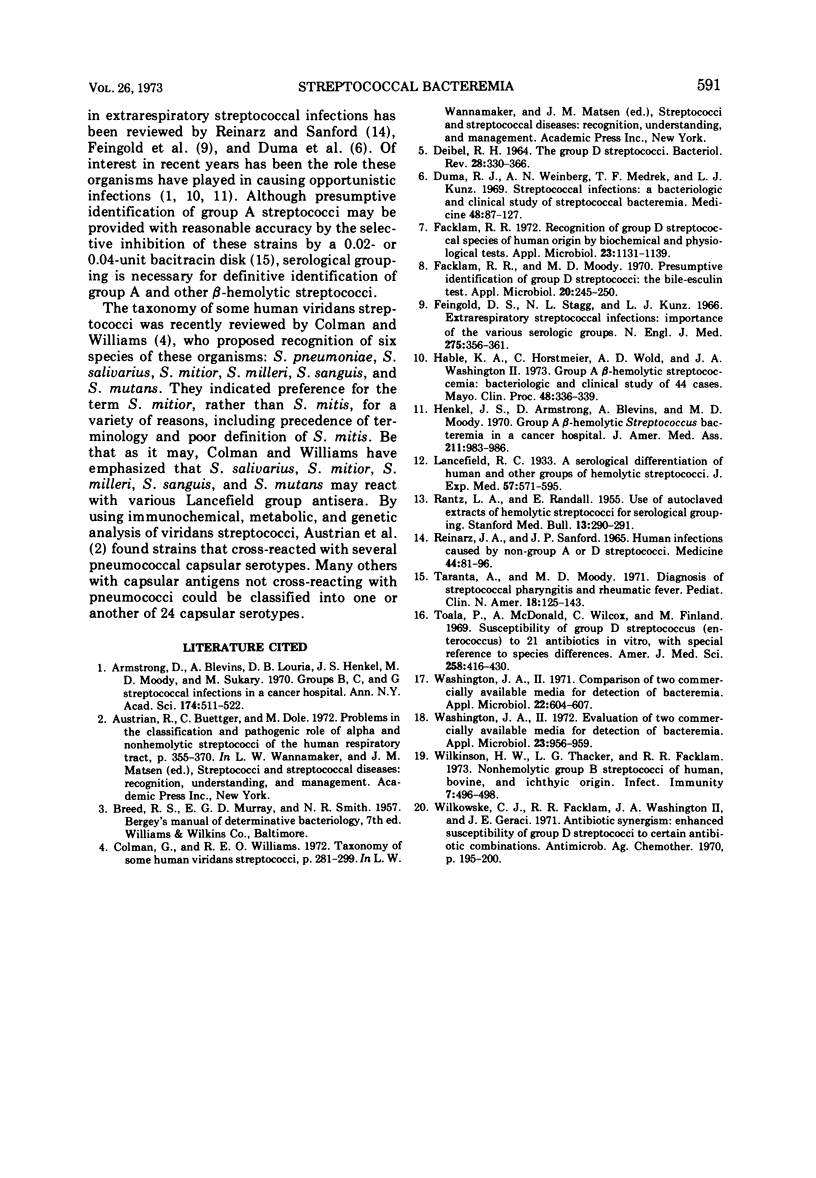Abstract
During a 2.5-year study, streptococci were isolated from 280 patients (19% of those with bacteremia). Of this number, 54 had group D streptococci (45 were enterococci), 218 had α- or γ-hemolytic nongroup D streptococci, and 49 had β-hemolytic streptococci.
Full text
PDF


Selected References
These references are in PubMed. This may not be the complete list of references from this article.
- Armstrong D., Blevins A., Louria D. B., Henkel J. S., Moody M. D., Sukany M. Groups B, C, and G streptococcal infections in a cancer hospital. Ann N Y Acad Sci. 1970 Oct 30;174(2):511–522. doi: 10.1111/j.1749-6632.1970.tb45577.x. [DOI] [PubMed] [Google Scholar]
- DEIBEL R. H. THE GROUP D STREPTOCOCCI. Bacteriol Rev. 1964 Sep;28:330–366. doi: 10.1128/br.28.3.330-366.1964. [DOI] [PMC free article] [PubMed] [Google Scholar]
- Facklam R. R., Moody M. D. Presumptive identification of group D streptococci: the bile-esculin test. Appl Microbiol. 1970 Aug;20(2):245–250. doi: 10.1128/am.20.2.245-250.1970. [DOI] [PMC free article] [PubMed] [Google Scholar]
- Facklam R. R. Recognition of group D streptococcal species of human origin by biochemical and physiological tests. Appl Microbiol. 1972 Jun;23(6):1131–1139. doi: 10.1128/am.23.6.1131-1139.1972. [DOI] [PMC free article] [PubMed] [Google Scholar]
- Feingold D. S., Stagg N. L., Kunz L. J. Extrarespiratory streptococcal infections. Importance of the various serologic groups. N Engl J Med. 1966 Aug 18;275(7):356–361. doi: 10.1056/NEJM196608182750704. [DOI] [PubMed] [Google Scholar]
- Hable K. A., Horstmeier C., Wold A. D., Washington J. A., 2nd Group A -hemolytic streptococcemia. Bacteriologic and clinical study of 44 cases. Mayo Clin Proc. 1973 May;48(5):336–339. [PubMed] [Google Scholar]
- Henkel J. S., Armstrong D., Blevins A., Moody M. D. Group A beta-hemolytic Streptococcus bacteremia in a cancer hospital. JAMA. 1970 Feb 9;211(6):983–986. [PubMed] [Google Scholar]
- RANTZ L. A., RANDALL E. Use of autoclaved extracts of hemolytic streptococci for serological grouping. Stanford Med Bull. 1955 May;13(2):290–291. [PubMed] [Google Scholar]
- REINARZ J. A., SANFORD J. P. HUMAN INFECTIONS CAUSED BY NON-GROUP A OR D STREPTOCOCCI. Medicine (Baltimore) 1965 Jan;44:81–96. doi: 10.1097/00005792-196501000-00003. [DOI] [PubMed] [Google Scholar]
- Toala P., McDonald A., Wilcox C., Finland M. Susceptibility of group D streptococcus (enterococcus) to 21 antibiotics in vitro, with special reference to species differences. Am J Med Sci. 1969 Dec;258(6):416–430. doi: 10.1097/00000441-196912000-00006. [DOI] [PubMed] [Google Scholar]
- Washington J. A., 2nd Comparison of two commercially available media for detection of bacteremia. Appl Microbiol. 1971 Oct;22(4):604–607. doi: 10.1128/am.22.4.604-607.1971. [DOI] [PMC free article] [PubMed] [Google Scholar]
- Washington J. A., 2nd Evaluation of two commercially available media for detection of bacteremia. Appl Microbiol. 1972 May;23(5):956–959. doi: 10.1128/am.23.5.956-959.1972. [DOI] [PMC free article] [PubMed] [Google Scholar]
- Wilkinson H. W., Thacker L. G., Facklam R. R. Nonhemolytic group B streptococci of human, bovine, and ichthyic origin. Infect Immun. 1973 Mar;7(3):496–498. doi: 10.1128/iai.7.3.496-498.1973. [DOI] [PMC free article] [PubMed] [Google Scholar]
- Wilkowske C. J., Facklam R. R., Washington J. A., 2nd, Geraci J. E. Antibiotics synergism: enhanced susceptibility of group D streptococci to certain antibiotic combinations. Antimicrob Agents Chemother (Bethesda) 1970;10:195–200. [PubMed] [Google Scholar]


